Safeguarding Blog
The ‘dreaded parent online safety evening’
“I’ve been asked to run a parent session on online safety – what should we do?” That’s a question we are often asked, often accompanied by a deep sigh because nobody came to the last one, or only the same people. Here are some suggestions. The ‘not-very-graphical graphic’ with below is a summary list to start with, or read on for a little more detail. And remember parentsafe.lgfl.net is the place where we signpost to helpful resources for this area.
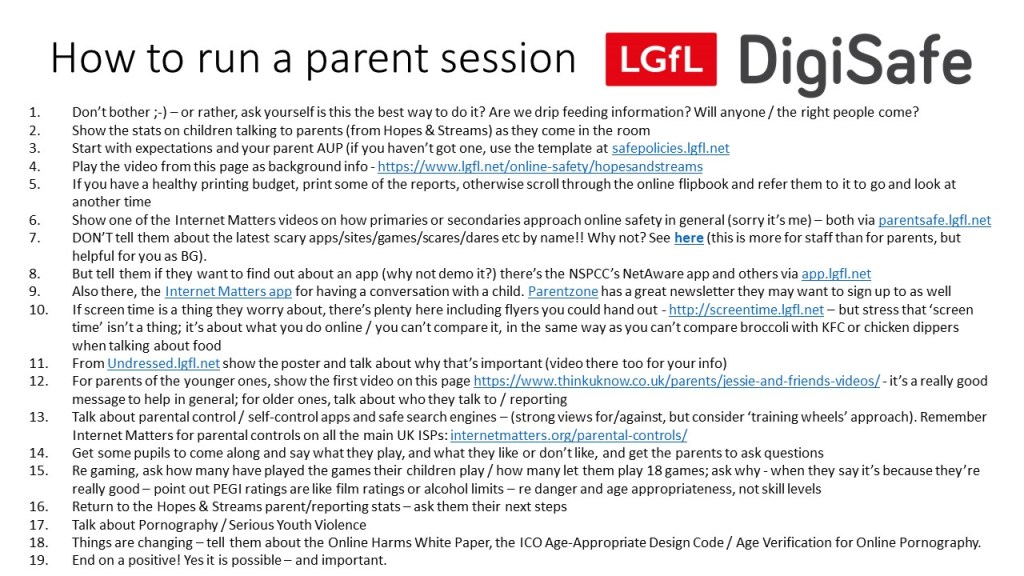
Caveat – read on to find out more about #1
Point 1 above (don’t bother!) isn’t intended to be provocative, but we always recommend drip-feeding information to parents throughout the year.
If you send home a regular newsletter about curriculum or events, why not add a pointer, reminder or resource each time. That is easy to do but can have a regular impact. If you are going to have a face-to-face sessions as well, and they can be very helpful, first consider whether a standalone big-bang approach once a year will be effective. Will parents come? Will the right ones come who you really want to be there? Will all the effort lead to sustainable change/support? If the answer to any of those is no, then maybe another approach is better. Why not add it onto an existing event, for example? Anyway, once you have decided how to approach it, here is just one of many ways you might approach it (remember the key is to customise for your setting, children and parents!).
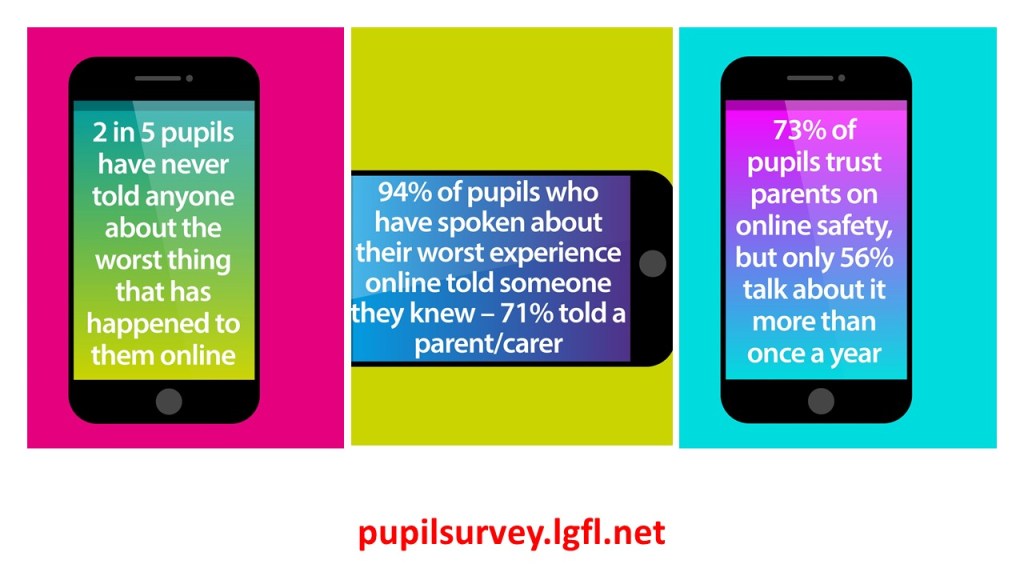
Point 2 – why not show the image above on screen as parents come into the session? The statistics are from Hopes & Streams, our survey of 40,000 young people. They speak for themselves but are certainly worth discussing – ask parents if they feel confident talking about online safety with their children, and point out how the first 2 stats show why it is so important that they do, and how the third one demonstrates that children recognise how adults’ life experience can be helpful, even on an app, site or game you’ve never heard of, let alone used – so it is worth it, and can help! We have a poster you may want to use with these stats as well here (from safeposters.lgfl.net).
Point 3 – if you haven’t got an ‘AUP’ (Acceptable Use Policy, which is actually more about behaviour than use), then get one! We have a template for you here. It’s no good just having one though – show it, talk it through and discuss why each point is important. Even if you fear some may ignore it, it gives you a foundation for any tricky conversations you may have in future. But above all, discussing the rationale for it with parents will probably mean that they will understand and adhere to it!
Points 4 & 5 – give some background to life online to young people by referring to our survey of 40,000 pupils from Primary and Secondary schools, Hopes & Streams. You could show the video from the page, or simply scroll through the flipbook to see some of the topics and quotes / statistics. Below are some of the themes, but see the report for statistics and quotes.
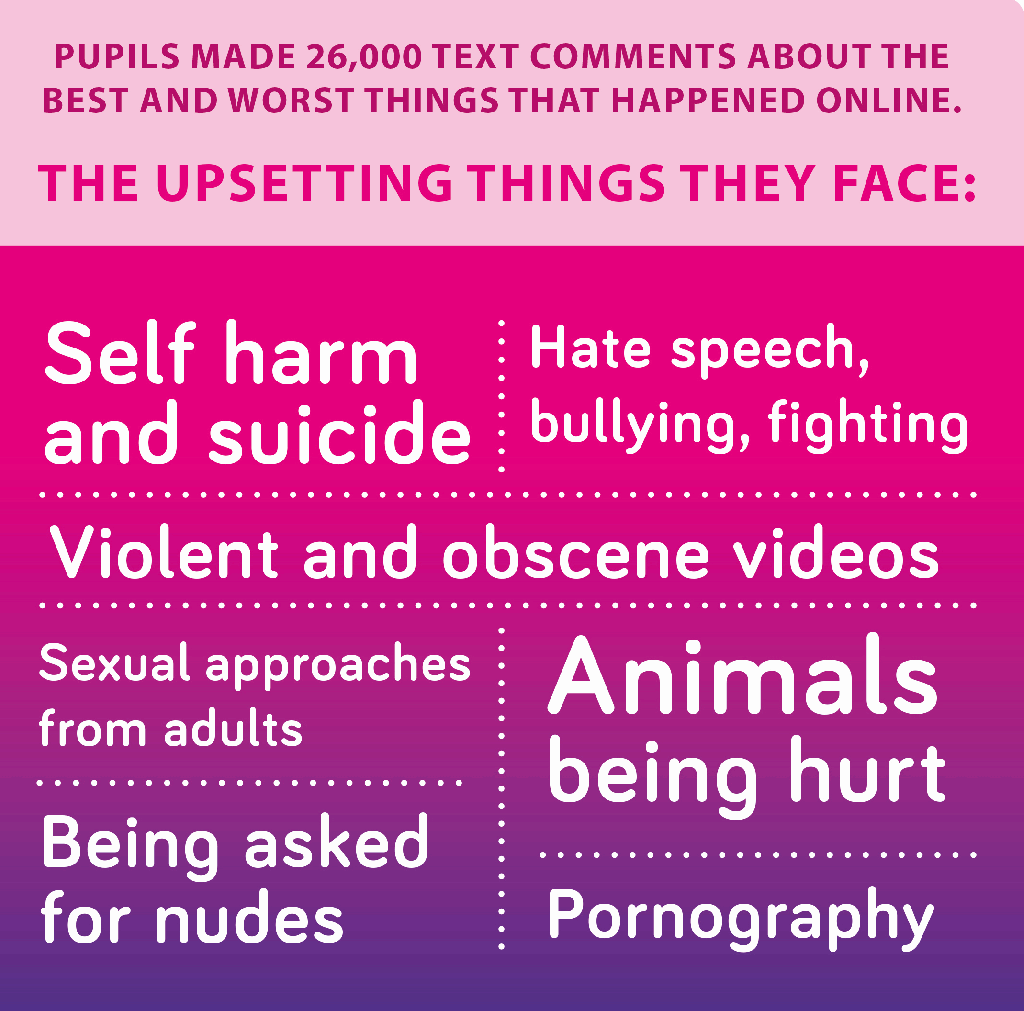
Point 6 – make sure you watch them first as you might get questions if you do things differently, but Internet Matters made videos to show parents what they might expect their children to cover at school in the area of online safety, either for Primary or Secondary.
As with everything on this list, you could also send it in advance, or as one of your weekly reminders, or…
Point 7 – this is a non-point. Please don’t include telling parents about the latest scary apps/sites/games/scares/dares etc by name!! Don’t give alist of bad apps or good apps. Why on earth not? See here (this is more for staff than for parents, but helpful for you as background to this).
Point 8 – However, if parents want to find out about a particular app (why not demo it?) there’s the NSPCC’s NetAware app which gives great overviews and summaries of the risks, opportunities and what parents/children think. Find this and others via apps.lgfl.net
Point 9 – While we’re talking apps, show parents the Internet Matters app for having a conversation with a child. It’s a great ipad app which an adult holds at one end and the child at the other (see below), and it gives you the conversation to have that you might otherwise be wary of! Parentzone has a great newsletter they may want to sign up to as well.
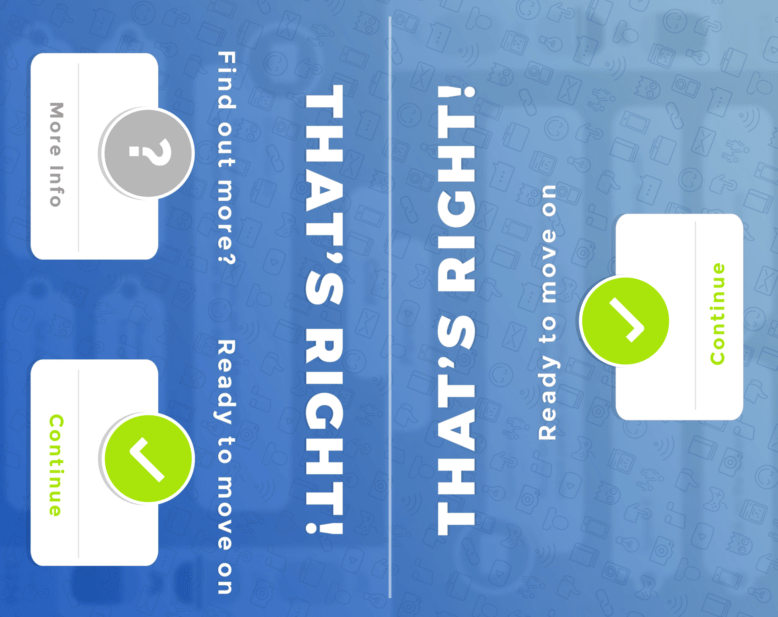
Point 10 – Screen time is often a concern for parents, but the best thing you can do is reassure them that ‘how long?’ isn’t as important as ‘what’ and having balance. screentime.lgfl.net has plenty including flyers you could hand out, plus a blog from us that explains a bit more about what to look for. Remember you can’t compare one bit of screen time with another, in the same way as you can’t compare broccoli with KFC or chicken dippers when talking about food – so beware people offering official time limits or polarising ‘good’ or ‘bad’ judgments.
Point 11 – Convey the really important message below for the youngest children who might get tricked into getting changed on camera (that risk is for all of them!). Find the full resolution poster below, why this is for the youngest pupils – and ALL of them – and a video explanation at undressed.lgfl.net.
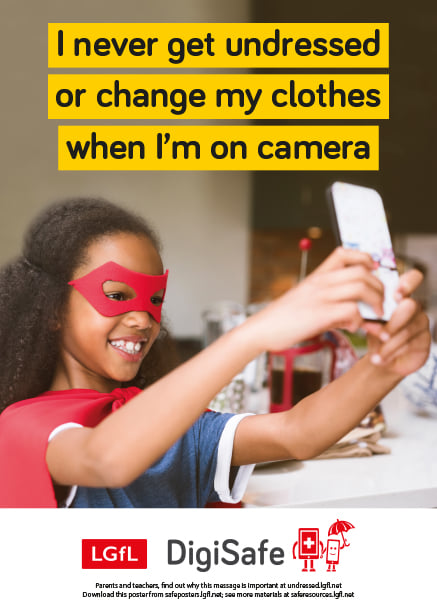
Point 12 – Again for younger pupils, but actually a key message for all children and young people (although the video is probably worth showing for all primary year groups even if it’s aimed at EYFS/KS1), show this great new video to parents and explain how important the message is for children to tell an adult if something feels funny in their tummy (and I dare you not to be singing the song for days! New from CEOP – Jessie & Friends has a really good message and for older children too, talk about who they talk to / reporting.
Point 13 – Talk about parental control / self-control apps and safe search engines. There are strong views for/against, but consider the ‘training wheels’ approach). There are safe search engines like Swiggle which are great for home use, and apps like Family Link from Google, Digital Wellbeing or similar apps (e.g. Quality Time) and Screen Time for Apple devices. Remember that these are great for easing children into their first device use, and as they get older, great for them (or for parents and teachers too!!) to regulate their own use and see how much time they really spend scrolling on Instagram. And remember Internet Matters tells you how to set parental controls on all the main UK internet service providers. That won’t solve everything, but it’s a start and important in the context of all the other point.
Point 14 – This point will make such a difference. Get some pupils to come along and say what they play, and what they like or don’t like, and get the parents to ask questions. You’ll be surprised, and so will the parents.
Point 15 – There’s gaming advice at gaming.lgfl.net and all manner of materials you may find useful, but why not simply ask how many parents have played the games their children play / how many let them play 18 games; ask why and remind parents that 18 games are not called 18 because of higher skills level, but because like films or alcohol, they are not age-appropriate and can cause long term damage. Rape, killing prostitutes, all manner of other attacks and murder, nudity and so on are commonplace with very lifelike graphics in some 18 games that primary children play! Do they know?
Point 16 – Having covered some of these points, why not return to the Hopes & Streams parent/reporting stats and ask them their next steps.
Point 17 – Talk about online pornography and Serious Youth Violence. We might not want to address such issues but they are a reality and there are great tools out there for all ages. ** Next week Childnet are launching great new online pornography materials – we will add them here once live **
Point 18 – Things are changing, especially in the UK which is leading the world with initiatives that are really making a change for the better – tell them about the Online Harms White Paper, the ICO Age-Appropriate Design Code / Age Verification for Online Pornography.
Point 19 – End on a positive! Yes it is possible – and important. Hopes & Streams has plenty of positives – one example is below. And of course use those you know about and ask your pupils for their examples – they will be the most powerful.
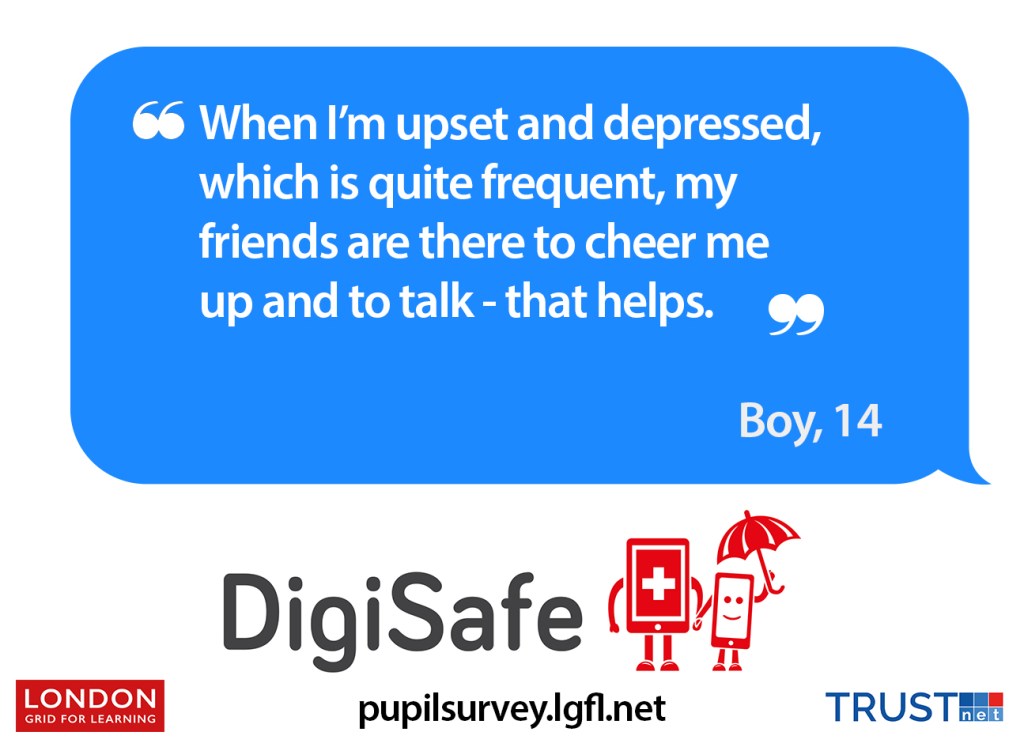
Point 20 – Start again! Keep it up and drip feed throughout the year. Well done; you’re doing a great job.
ADDENDUM – only a few hours have passed but I keep thinking of new things to add, e.g. if you are going to invite an outside speaker to deliver a parent session, consider if that’s the best thing (sometimes it will be a great idea but they won’t be there to answer any questions from parents in future), but use the UKCIS document Using External Visitors to Support Online Safety Education to help make sure they are the best person for the job.
This blog has been adapted from a presentation given at the LGfL curriculum conference on 25/4/19. If you were there and would like to see the slides again, click here.

